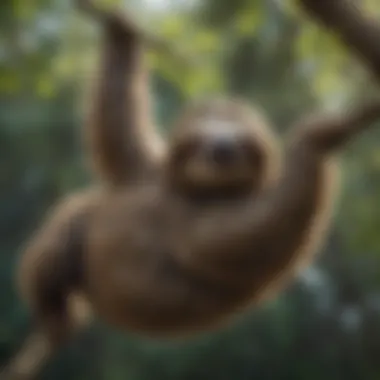Unlocking the Enigma of Sloth Movement: An In-Depth Study


Nature Topic Overview
Sloths, fascinating creatures of the wilderness, have intrigued scientists and nature enthusiasts alike with their unique movement patterns. This detailed exploration aims to uncover the mysteries behind sloth locomotion and shed light on their remarkable abilities.
Fun Facts and Trivia
- Sloths are known for their incredibly slow movement, as they spend most of their lives hanging upside down in trees
- Despite their leisurely pace, sloths are surprisingly good swimmers, using their long arms to navigate through water effortlessly
- These charming creatures have a special adaptation for survival - their fur hosts algae, camouflaging them among trees while providing important nutrients
Wildlife Explorations
Within the world of sloths, there are two main species: two-toed sloths and three-toed sloths. Each species exhibits distinct characteristics in terms of behavior and habitat preferences.
In their native habitats of Central and South America, sloths play a crucial role in maintaining ecosystem balance. From feasting on foliage to dispersing seeds, sloths are integral to the health of tropical forests.
For those seeking a deeper dive into sloth knowledge, interactive quizzes and puzzles can aid in exploring the intricacies of these creatures' lives.
Environmental Awareness
The conservation of sloth habitats is paramount for their survival. As deforestation continues to threaten their homes, it is essential to raise awareness about the importance of preserving these ecosystems.
Educating children on sustainable practices and encouraging them to participate in conservation efforts can make a significant difference in safeguarding sloths and their environment.
DIY Nature Activities
Engage young minds in the wonders of sloth movement through hands-on activities. Crafting sloth-inspired creations or embarking on outdoor expeditions that mimic the behavior of sloths can ignite a passion for wildlife conservation.
Encouraging children to observe nature closely and learn from these gentle creatures fosters a deeper appreciation for the natural world and instills a sense of responsibility towards its protection.


Introduction
Sloths, the epitome of slow-paced existence, have captivated the curiosity of mankind for centuries. This article embarks on a meticulous exploration of their unique locomotion techniques and delves into the intricacies of sloth movement. As we unravel the mysteries behind how sloths navigate their environment, a world of wonder and fascination unfolds before us.
Exploring the Curious World of Sloths
The enigmatic nature of sloths has long been a source of intrigue for researchers and nature enthusiasts alike. These arboreal creatures, with their deliberate movements and almost meditative demeanor, offer a glimpse into a lifestyle that defies conventional norms. By observing their behaviors in their natural habitat, we can uncover a treasure trove of insights into their adaptive strategies and survival techniques.
Significance of Studying Sloth Movement
Studying sloth movement transcends mere academic curiosity; it provides a key to unlocking the secrets of evolution and adaptation in the animal kingdom. By investigating how sloths navigate their environment with such efficiency despite their slow pace, we gain invaluable knowledge that can inform fields ranging from biomechanics to conservation biology. Understanding sloth movement is not just an intellectual pursuit; it is a gateway to appreciating the marvels of nature's ingenuity and resilience.
Physical Adaptations for a Slow Lifestyle
In this segment of our detailed investigation into sloth movement, we delve into the intrinsic importance of physical adaptations that enable sloths to thrive in their slow-paced existence. Understanding the physical attributes that contribute to their unique lifestyle sheds light on the remarkable ways sloths have evolved to survive and thrive in their arboreal habitats. Sloths possess an array of specialized characteristics, ranging from their distinct anatomy to their physiological features, all finely tuned to support their unhurried way of life.
These adaptations play a crucial role in shaping every aspect of a sloth's everyday routine, influencing its movement patterns, foraging strategies, and even social interactions. By closely examining these adaptations, we can appreciate the intricate relationship between form and function in the evolutionary history of sloths. From their slow metabolism to their specialized muscles, each adaptation reflects a meticulous adaptation to their environment, highlighting the delicate balance between survival and efficiency.
The extraordinary adaptations of sloths extend beyond their physical structure, encompassing a complex interplay of biological mechanisms that regulate their energy expenditure and behavioral responses. By exploring these adaptations in detail, we gain a deeper understanding of the interconnected web of factors that shape the distinctive lifestyle of sloths, offering a glimpse into the evolutionary marvels of the natural world.
Anatomy and Physiology of Sloths
As we delve into the intricacies of sloth anatomy and physiology, we uncover a tapestry of specialized adaptations that enable these charismatic creatures to navigate their arboreal environment with unparalleled ease. From their reduced muscle mass to their unique skeletal structure, every aspect of a sloth's physiology reflects a remarkable blend of form and function honed by millennia of evolutionary refinement.
The anatomy of sloths is intricately suited to their arboreal lifestyle, characterized by a reduced body mass index and a distinctive skeletal morphology that enables them to move with remarkable efficiency through the dense canopy. Their specialized bone structure, coupled with adaptations in muscle distribution, allows sloths to maintain a slow yet steady pace as they traverse across tree branches, showcasing the remarkable agility of these seemingly lethargic animals.
In addition to their skeletal adaptations, sloths exhibit unique physiological traits that further enhance their arboreal prowess. Their slow metabolic rate, coupled with specialized digestive processes, enables sloths to thrive on a diet primarily composed of leaves, a resource that would be indigestible to most other mammals. By unraveling the intricacies of sloth anatomy and physiology, we gain a deeper appreciation for the extraordinary adaptations that have shaped these enigmatic animals into masters of their forest domain.
Understanding Sloth Muscle Structure


Delving into the fascinating realm of sloth muscle structure, we uncover a myriad of adaptations that underpin their distinctive locomotor abilities. Contrary to traditional beliefs, sloths possess specialized muscle compositions that are finely tuned to support their unique mode of movement, characterized by a deliberate and unhurried pace.
Sloth muscles exhibit a high proportion of slow-twitch fibers, allowing them to sustain prolonged bouts of activity without experiencing fatigue. This adaptation is essential for sloths, as their slow-paced lifestyle necessitates a muscular framework that can support extended periods of hanging and climbing in the treetops. By dissecting the nuanced muscle structure of sloths, we gain insight into the specialized adaptations that enable these creatures to excel in their arboreal habitat.
Moreover, sloth muscle structure also plays a pivotal role in regulating their metabolic rate and energy expenditure. The unique composition of their muscles dictates the pace and duration of their movement, aligning perfectly with their energy-conserving lifestyle. By unraveling the complexities of sloth muscle structure, we unravel the functional intricacies that distinguish these creatures as masterful survivors in the world of slow-moving beings.
The Role of Sloth Claws in Movement
Exploring the significance of sloth claws in facilitating their distinctive movement patterns unveils a fundamental aspect of their arboreal lifestyle. Sloth claws represent a crucial adaptation that enables these creatures to navigate their treetop habitats with unparalleled dexterity, gripping onto branches and foliage with remarkable precision.
The specialized structure of sloth claws, characterized by elongated and curved digits, allows them to firmly grasp onto tree surfaces, providing stability and support as they move slowly through the canopy. This unique morphology is finely tuned to the demands of their arboreal lifestyle, offering a secure grip that minimizes the risk of falls or accidents while traversing the tree tops.
Moreover, sloth claws play a crucial role in enhancing their foraging capabilities, enabling them to reach and grip onto leaves and branches with ease. This adaptation is integral to their survival, as it enables sloths to access their primary food source while minimizing energy expenditure and maximizing efficiency. By examining the role of sloth claws in their movement repertoire, we gain a deeper appreciation for the intricate adaptations that define these iconic denizens of the forest canopy.
Arboreal Locomotion: The Slow Climb
Arboreal Locomotion, focusing on the slow climb of sloths, plays a pivotal role in understanding sloth movement patterns. Sloths have evolved to thrive in tree canopies, adopting a unique climbing technique that sets them apart from other species. The deliberate and gradual nature of their ascent is a key survival strategy, enabling them to conserve energy and navigate their arboreal habitat efficiently. By delving into the specifics of the slow climb, we can decipher the intricacies of sloth locomotion and unravel the secrets behind their gradual yet purposeful movements.
Hanging Around: Sloths' Unique Adaptations
Sloths' unique adaptations are prominently displayed in their ability to hang upside down for extended periods. This distinctive behavior showcases their specialized anatomical features, such as their strong grip aided by sharp claws and specialized musculature. By hanging around, sloths minimize energy expenditure while optimizing their foraging abilities, a crucial aspect of their survival in tree-dwelling environments. Exploring these adaptations offers insights into the remarkable evolutionary path that has shaped the sloth's arboreal lifestyle.
Climbing Strategies of Tree-Dwelling Sloths
The climbing strategies employed by tree-dwelling sloths provide a fascinating glimpse into their ecological niche. Sloths utilize a combination of slow, deliberate movements and specialized limb coordination to navigate the intricate network of branches in their habitat. By detailing these climbing strategies, we can appreciate the precision and efficiency with which sloths ascend and descend trees, highlighting their exceptional agility and adaptability to arboreal environments.
Sloth's Movement in Canopy: Slow and Steady Wins the Race
Sloth's movement in the canopy exemplifies the adage 'slow and steady wins the race.' By observing how sloths traverse the treetops with measured pace and deliberate motions, we gain valuable insights into their foraging behaviors and social interactions. The deliberate pace of their movements not only conserves energy but also allows them to maintain a vigilant watch over their surroundings, a crucial aspect of survival in the dense canopy. Exploring the significance of slow and steady movement in sloths unveils a captivating narrative of adaptation and resilience in their arboreal realm.


Surprising Skills: Sloths in Water
In this riveting exploration of sloth movement, a crucial section unfolds dedicated to understanding the exceptional skills of sloths in water. This topic offers a unique perspective on sloths' capabilities beyond their renowned arboreal behaviors. Delving into the realm of aquatic movement, we uncover a lesser-known facet of these intriguing creatures that adds depth to our understanding of their adaptability and survival strategies.
Sloths' Surprising Swimming Abilities
Within the watery domain, sloths exhibit surprising swimming abilities that defy their slow-paced reputation on land. Despite their inherent sluggishness, sloths showcase a remarkable adeptness in navigating through water with unexpected agility. By dissecting the nuances of their swimming techniques, we gain valuable insights into how sloths harness their physical adaptations to excel in this challenging environment, unravelling the mysteries of their aquatic prowess.
Adaptations for Aquatic Movement
As we explore the adaptations that facilitate sloths' aquatic movement, a tapestry of intricate biological features comes to light. From their unique fur texture that aids in buoyancy to specialized limb structures that enable efficient propulsion, each adaptation serves a distinct purpose in enhancing sloths' efficiency in water. By understanding these evolutionary marvels, we unravel the evolutionary journey that has equipped sloths with the tools necessary to navigate through aquatic realms with calculated ease and grace, painting a holistic picture of their extraordinary adaptability.
Factors Influencing Sloth Movement
In this extensive investigation of sloth movement, the section on Factors Influencing Sloth Movement holds a crucial position in unraveling the secrets of these enigmatic creatures. By delving deep into the various factors that influence how sloths move, we gain profound insights into their behavior and ecological significance. Understanding these factors enriches our appreciation for the intricacies of sloth locomotion. Benefits of exploring Factors Influencing Sloth Movement: By exploring how factors like diet and environment shape sloth movement patterns, we can enhance conservation efforts and contribute to scientific research on these fascinating animals. Key elements to consider: Diet plays a significant role in dictating a sloth's energy levels and, consequently, its movement habits. Environmental influences, such as habitat destruction or climate change, can impact the availability of food sources and nesting sites for sloths, thereby influencing their movement behaviors. Relevance of Factors Influencing Sloth Movement: Examining these factors not only sheds light on the adaptation strategies of sloths but also highlights the importance of preserving their natural habitats for their continued survival and well-being.
Impact of Diet on Sloth Locomotion
The impact of diet on sloth locomotion is a critical aspect of understanding how these animals navigate their environment. Sloths have evolved to have a slow metabolism due to their predominantly leaf-based diet. Their diets, rich in fibrous vegetation, provide low energy returns, which directly affect their movement. Sloths conserve energy by moving slowly and deliberately to compensate for the limited energy gained from their food sources. This unique adaptation allows them to thrive in their arboreal habitats, where they can sustain themselves on a diet that other animals may find insufficient. By investigating the impact of diet on sloth locomotion, we gain a deeper appreciation for the intricate relationship between their physiology, behavior, and ecological niche.
Environmental Influences on Sloth Behavior
The behavior of sloths is intricately linked to their surrounding environment. Environmental influences play a significant role in shaping how sloths interact with their habitat and other organisms. Factors such as temperature, humidity, and vegetation density can affect sloth behavior, ranging from their movement patterns to their nesting preferences. As climate change and deforestation increasingly alter sloths' habitats, understanding how environmental influences impact sloth behavior becomes even more critical. By examining these influences, we can better comprehend the challenges sloths face in adapting to changing environmental conditions and aid in the development of conservation strategies to protect these remarkable creatures.
Conclusion
In this article, the significance of understanding the movement of sloths has been thoroughly explored, shedding light on the intricate world of these fascinating creatures. By delving deep into the various aspects of sloth locomotion, we have uncovered not just how they move but also why it matters in the broader spectrum of nature's wonders. Through a meticulous examination of their physical adaptations, arboreal locomotion, surprising skills in water, and the factors influencing their movement, we have gained a profound insight into the complexities of sloth behavior.
The compelling nature of sloth movement lies in its interconnectedness with their environment, diet, and evolutionary history. By unraveling the secrets behind their slow and deliberate tree-climbing, we come to appreciate the marvel of nature's design. Understanding the significance of sloth movement is not just about unraveling biomechanical mysteries; it provides a window into the resilience of life forms adapting to diverse habitats. By grasping the nuances of their locomotion, we can better comprehend the ecological equilibrium that sustains these remarkable creatures. The implication of this knowledge stretches beyond sloths themselves, offering valuable lessons in evolution, adaptation, and coexistence in the natural world.
Summarizing the Intriguing World of Sloth Movement
In summarizing the intriguing world of sloth movement, it becomes evident that these seemingly lethargic creatures possess a myriad of adaptations that enable their survival in unique habitats. From their specialized muscle structure facilitating slow yet efficient movement to the remarkable agility displayed in water, sloths defy conventional expectations. Their ability to thrive in diverse environments while maintaining a leisurely pace challenges preconceived notions about effective locomotion.
Exploring the curious world of sloths expands our understanding of evolution's intricacies, showcasing nature's ingenuity in carving out specialized niches for each species. By closely examining the role of diet, environmental influences, and anatomical features in shaping sloth movement, we gain a holistic perspective on the interconnectedness of biological systems. This journey into the realm of sloth locomotion beckons us to appreciate the subtle nuances and adaptive strategies that underscore their conservation significance. In a world where speed often defines success, sloths remind us of the beauty in taking life at a different pace, embracing deliberate movement as a hallmark of survival strategy.







